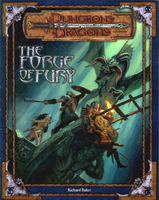A complaint I’ve heard more than once regarding player behavior in the age of Third Edition is “videogame style play”—more specifically, a style of behavior in which players have their characters fight, rest up, fight, rest up, ad nauseam, plodding straight ahead with little thought of serious problem-solving, alternate routes, or flight (especially the latter).
Now the videogame criticism is over-played by many RPG old-timers and often unfairly directed against many younger players in particular, but I do understand the point. The style of play described works fine in an electronic game such as Call of Duty, of which I happen be a fan, but in D&D the straightforward approach isn’t always the best or only route—and it shouldn’t be.
In this time of Third Edition ELs, CRs, and other alphabet soup game guidelines, it’s easy for players to be lulled into a false sense of security. They know a good GM follows these guidelines, so they trust that an adventure will be balanced with regard to PC levels. Taken at face value, this is fine—players have every right to expect that their characters will be neither unduly slaughtered nor so lacking for challenge that they will fall asleep. At a certain point however, this strains credibility. Why do purple worms never seem to lurk in the same cavern complexes populated by gricks or chokers? ("Well, because their challenge ratings are too far apart, you see...") Using the challenge levels properly also leads to an abundance of humanoids at the lower levels, I've seen.
I enjoy low-level play—there’s a real challenge when a few hits can really threaten your characters (and a possible critical hit on a PC becomes a truly terrifying event)—but I am soooo sick of the goblins. Getting from 1st level to 5th level without fighting goblins, hobgoblins, orcs, or kobolds is a near-impossible event. I like humanoids as much as the next guy, but the obligatory humanoid stomp on the way up the XP ladder is getting old. I’m an old 1st- and 2nd Edition player, and I’ve seen many, many characters of mine never get past 6th level, so maybe that’s part of the problem, I don’t know. As I said once to a friend of mine that is a great fan of low-level, humanoid-heavy play, “I’m getting tired of chalking up … I want to shoot pool* sometimes too.” Everybody likes a good, crowded kobold smash sometimes, and occasionally it even makes for good comic relief, but more often it’s the hydras and behirs and black dragons that make for the special battles we really remember.

The ability to level up nearly any monster or humanoid in Third Edition has added a welcome surprise factor (and added danger) to some of the more mundane encounters, but in this writer’s humble opinion there’s nothing wrong with the characters running away when needed. Adding one encounter per adventure that is a bit more than the PC party can chew isn’t a sin … it might be a welcome dose of reality.
In The Scaly God, I added an encounter that was extremely dangerous—one that any sensible party would back away from if the scene if GMed properly. I went as far as to include a warning note for the GM in the module, telling her that it would be fair play to warn the party that real trouble lies ahead.
 Richard Baker did something similar in his Forge of Fury adventure. In this 3rd-level adventure, there is an area in which dwells a roper. That’s right … a roper! Allowing PCs in a 3rd-level dungeon to possibly run into a CR 12 creature is perhaps madness, but Baker did it with style, including notes for the GM. Call me a heretic, but I see nothing wrong with this so long as the author and GM play fair about it.
Richard Baker did something similar in his Forge of Fury adventure. In this 3rd-level adventure, there is an area in which dwells a roper. That’s right … a roper! Allowing PCs in a 3rd-level dungeon to possibly run into a CR 12 creature is perhaps madness, but Baker did it with style, including notes for the GM. Call me a heretic, but I see nothing wrong with this so long as the author and GM play fair about it.Sometimes too much is too much, and, given some warning, the adventurers should realize that sometimes it’s best to skedaddle and live to fight another day.
*Lousy metaphor. As some of the Goodman Games folks can atest, I'm no pool shark.

